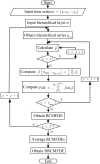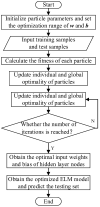A Novel Fault Diagnosis Method for Rolling Bearing Based on Hierarchical Refined Composite Multiscale Fluctuation-Based Dispersion Entropy and PSO-ELM
- PMID: 36359611
- PMCID: PMC9689796
- DOI: 10.3390/e24111517
A Novel Fault Diagnosis Method for Rolling Bearing Based on Hierarchical Refined Composite Multiscale Fluctuation-Based Dispersion Entropy and PSO-ELM
Abstract
This paper proposes a novel fault diagnosis method for rolling bearing based on hierarchical refined composite multiscale fluctuation-based dispersion entropy (HRCMFDE) and particle swarm optimization-based extreme learning machine (PSO-ELM). First, HRCMFDE is used to extract fault features in the vibration signal at different time scales. By introducing the hierarchical theory algorithm into the vibration signal decomposition process, the problem of missing high-frequency signals in the coarse-grained process is solved. Fluctuation-based dispersion entropy (FDE) has the characteristics of insensitivity to noise interference and high computational efficiency based on the consideration of nonlinear time series fluctuations, which makes the extracted feature vectors more effective in describing the fault information embedded in each frequency band of the vibration signal. Then, PSO is used to optimize the input weights and hidden layer neuron thresholds of the ELM model to improve the fault identification capability of the ELM classifier. Finally, the performance of the proposed rolling bearing fault diagnosis method is verified and analyzed by using the CWRU dataset and MFPT dataset as experimental cases, respectively. The results show that the proposed method has high identification accuracy for the fault diagnosis of rolling bearings with varying loads and has a good load migration effect.
Keywords: feature extraction; hierarchical refined composite multiscale fluctuation-based dispersion entropy (HRCMFDE); load migration; particle swarm optimization-based extreme learning machine (PSO-ELM); rolling bearing fault diagnosis.
Conflict of interest statement
The authors declare no conflicts of interest.
Figures


















Similar articles
-
Refined composite moving average fluctuation dispersion entropy and its application on rolling bearing fault diagnosis.Rev Sci Instrum. 2023 Oct 1;94(10):105110. doi: 10.1063/5.0165430. Rev Sci Instrum. 2023. PMID: 37819206
-
Intelligent Diagnosis of Rolling Element Bearing Based on Refined Composite Multiscale Reverse Dispersion Entropy and Random Forest.Sensors (Basel). 2022 Mar 6;22(5):2046. doi: 10.3390/s22052046. Sensors (Basel). 2022. PMID: 35271193 Free PMC article.
-
Intelligent Fault Diagnosis of Rolling-Element Bearings Using a Self-Adaptive Hierarchical Multiscale Fuzzy Entropy.Entropy (Basel). 2021 Aug 30;23(9):1128. doi: 10.3390/e23091128. Entropy (Basel). 2021. PMID: 34573753 Free PMC article.
-
A New Method Based on Time-Varying Filtering Intrinsic Time-Scale Decomposition and General Refined Composite Multiscale Sample Entropy for Rolling-Bearing Feature Extraction.Entropy (Basel). 2021 Apr 11;23(4):451. doi: 10.3390/e23040451. Entropy (Basel). 2021. PMID: 33920417 Free PMC article.
-
A Review on Rolling Bearing Fault Signal Detection Methods Based on Different Sensors.Sensors (Basel). 2022 Oct 30;22(21):8330. doi: 10.3390/s22218330. Sensors (Basel). 2022. PMID: 36366032 Free PMC article. Review.
Cited by
-
A New Approach to the Degradation Stage Prediction of Rolling Bearings Using Hierarchical Grey Entropy and a Grey Bootstrap Markov Chain.Sensors (Basel). 2023 Nov 9;23(22):9082. doi: 10.3390/s23229082. Sensors (Basel). 2023. PMID: 38005469 Free PMC article.
-
Multiscale Entropy-Based Feature Extraction for the Detection of Instability Inception in Axial Compressors.Entropy (Basel). 2024 Jan 2;26(1):48. doi: 10.3390/e26010048. Entropy (Basel). 2024. PMID: 38248174 Free PMC article.
References
-
- Yan X., Jia M. A novel optimized SVM classification algorithm with multi-domain feature and its application to fault diagnosis of rolling bearing. Neurocomputing. 2018;313:47–64. doi: 10.1016/j.neucom.2018.05.002. - DOI
-
- Rai A., Upadhyay S. A review on signal processing techniques utilized in the fault diagnosis of rolling element bearings. Tribol. Int. 2016;96:289–306. doi: 10.1016/j.triboint.2015.12.037. - DOI
-
- Liu R., Yang B., Zio E., Chen X. Artificial intelligence for fault diagnosis of rotating machinery: A review. Mech. Syst. Signal Process. 2018;108:33–47. doi: 10.1016/j.ymssp.2018.02.016. - DOI
-
- Yang L., Chen H. Fault diagnosis of gearbox based on RBF-PF and particle swarm optimization wavelet neural network. Neural Comput. Appl. 2018;31:4463–4478. doi: 10.1007/s00521-018-3525-y. - DOI
Grants and funding
LinkOut - more resources
Full Text Sources

